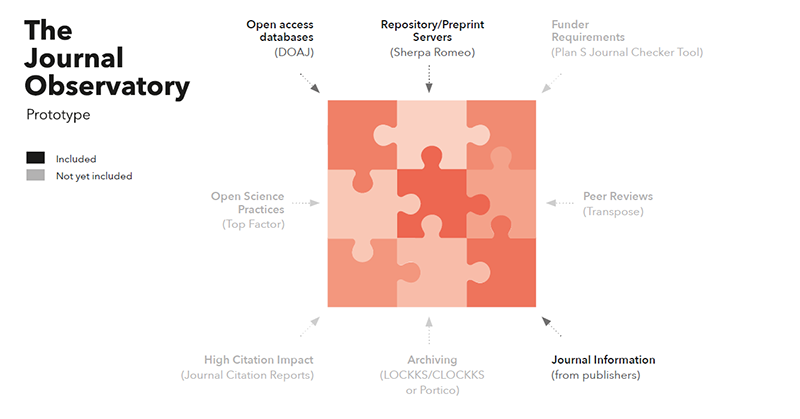The Journal Observatory - Connecting information on scholarly communication
As scholarly communication is getting more diverse and transparent, there is an increasing need for reliable information on platforms’ policies. The Journal Observatory project aims to connect existing data and build toward systematic high-quality information on scholarly communication platforms.
The scientific community is moving towards a more transparent way of conducting and reporting research. Scientific publications are becoming more and more openly accessible but openness should also extend to peer review, preprinting, preregistration, data sharing, metadata availability, and related issues.
Research funders and other stakeholders are putting a significant effort into promoting open science practices in scholarly communication. But there is a lack of high-quality infrastructure that provides information on the openness, policies and procedures of scholarly journals and other publication outlets. Consequently, it can be challenging to answer questions like: how do journals organize quality assurance and peer review? How do journals support open access publishing? How do journals or preprint servers support preregistration, preprinting, and data sharing? How diverse are the editorial teams of journals?
This information can be crucial to multiple stakeholders:
 |  |  |  |
Researchers | Publishers | Funders, research institutions and libraries | All stakeholders |
need this information to decide which journals to engage with as reader, author, reviewer, or editor. | need this information to advertise the distinctive features of their journals, to demonstrate the investments they make in their journals, and to attract readers, authors, reviewers, and editors. | need this information to inform negotiations with publishers, to support the development of publication policies, and to assess and reward the compliance with these policies. | will benefit from high- quality information to explore, assess and develop novel publication and review models. |
The Journal Observatory project aims to contribute to making available the information needed by these stakeholders.
The current landscape, and its shortcomings
There are numerous initiatives and platforms providing some part of the puzzle, but information is scattered, incomplete, and difficult to compare. For example, tools and databases are available that help researchers understand how to make their research openly accessible (DOAJ), whether their work can be posted in a repository or on a preprint server (Sherpa Romeo), how to ensure compliance with funder requirements (Plan S Journal Checker Tool), and how to pick a publication platform that offers particular peer review approaches (Transpose), open science practices (TOP factor), or that is considered to have a sufficiently high citation impact (Journal Citation Reports).
Given this complexity, it seems unrealistic to expect stakeholders to know which tools or databases to use to obtain specific information.
As new models of publishing such as Publish-Review-Curate, publication as you go, preprint review and others emerge, distinct publishing functions like dissemination and evaluation are increasingly decoupled. This creates the need for different platforms to interact and at least to be aware of each other’s policies and requirements. At present, there are minimal standards to enable the systematic interoperability of these platforms. At the research output level, standards like DocMaps and the COAR Notify protocol are under development. However, to empower further innovation in scholarly communication, a shared way to describe these different platforms and their possibilities of interaction is required.
The Journal Observatory project: aims and approach
To address this challenge, our project aims to:
define an extensible, machine-readable and traceable way to describe the policies and practices of the various platforms involved in disseminating and evaluating scholarly works: the Scholarly Communication Platform Framework
demonstrate the value of this new framework by building a demonstration prototype called the Journal Observatory, a resource which combines data on journals and other publication platforms from various sources to clarify policy information for authors, reviewers and others.
1. Scholarly Communication Platform Framework
The Scholarly Communication Platform Framework is a new, high-level, structured language that enables the exchange of information about platforms for scholarly communication. To date, we have focused on enabling description of platforms for the dissemination and/or evaluation of research articles, such as scientific journals, preprint servers, and peer review platforms. However, the Framework can fairly easily be extended in the future to describe platforms performing other scholarly communication functions (e.g., archiving via platforms like LOCKKS/CLOCKKS or Portico), or to describe dissemination/evaluation of other types of scholarly outputs (books, datasets, software, code, methods, materials). The detailed inner-workings and rationale of the Framework are described in our technical report. Documentation and source code can be found on the project’s webpage.
2. Journal Observatory prototype
The Journal Observatory prototype is a proof-of-concept demonstrator which integrates journal information from diverse open data sources including DOAJ, Sherpa Romeo and others, as well as directly from publishers. It shows the power of combining information from these different sources to support three primary use-case areas: open access publishing, preprinting and peer review procedures. By making this information available, we support researchers, publishers, funders and research institutions to make informed decisions and monitor compliance. The prototype comes both with interfaces for machines and with a user-friendly web interface for humans. There are two interfaces for machines: a SPARQL endpoint and a REST API. The web interface for humans is provided by the Journal Observatory Browser. More information about the prototype, including documentation and source code, can be found on the project’s webpage.

Next steps
The Journal Observatory project has achieved much within a limited timeframe and with limited resources. We see our project and its outputs as the start or continuation, not the end, of a much larger conversation. We hope our work will provide a base for a more ambitious long-term agenda, co-shaped with the wider scholarly community, and aimed at working toward open and interoperable infrastructure for providing systematic and reliable information on scholarly journals and other scholarly communication platforms.
The community event
To mark the end of the project and to launch the project’s results, we organized an online community event on April 25. During the event, we presented our work, including a live demo of the Journal Observatory Browser to show how the tool can support users in efficiently finding answers to questions like: what journals in my field (e.g. sustainability research) provide options for Diamond Open Access publishing? How do the preprinting policies of two journals compare? What journals in my field adhere to Open Peer Review, in the sense of publishing review reports?
The demonstration was followed by Lucy Ofiesh’s (Director of Finance & Operations at Crossref) talk on the Principles of Open Scholarly Infrastructure (POSI). Lucy described how these principles, developed as a community resource to help guide organizations, can support the resilience and sustainability of open infrastructure that serves the scholarly communications ecosystem.
The event was concluded by a panel discussion in which three of the project’s stakeholder advisory board members discussed their perspective on the need and future of interoperable, systematically-collected information on scholarly communication platforms. Johan Rooryck (Executive Director of cOAlition S), Catriona MacCallum (Director of Open Science at Hindawi Publishing) and Gabe Stein (Head of Operations and Product at the Knowledge Futures Group) shared their view from the perspective of a research agency coalition, publisher and infrastructure provider, respectively. They agreed that there is a dire need for the kind of service provided by initiatives like the Journal Observatory project, but also identified several challenges on the road towards sustainability of such initiatives.
The recording of the event can be watched here.
Get involved!
We call upon all within the scholarly communications community to work collaboratively to advance these aims. If you are interested to discuss potential collaboration with us or have ideas about how to take this forward, please contact us via Ludo Waltman, Journal Observatory project lead.
Acknowledgement
The Journal Observatory project was supported by the Open Science Fund of the Dutch Research Council (NWO).
We thank Melanie Imming and Mathijs van Woerkum (im-studio) for their contributions to the illustrations in this blogpost and all members of our stakeholder advisory board for their valuable input to our project.







0 Comments
Add a comment